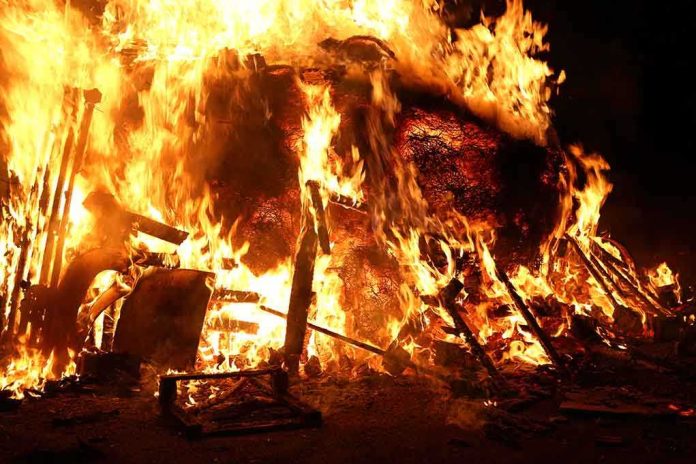
A gunman turned a peaceful Sunday morning at a Michigan Mormon church into a nightmare of bullets and flames, leaving five dead and eight wounded in what authorities are calling one of the most disturbing attacks on a house of worship in recent memory.
Story Overview
- Five people died and eight were injured when a gunman opened fire at a Church of Jesus Christ of Latter-day Saints in Grand Blanc, Michigan
- The attacker drove a truck through the church entrance before opening fire and setting the building ablaze
- The suspect was killed during the confrontation, ending the immediate threat
- The attack has sent shockwaves through religious communities nationwide, raising urgent questions about worship safety
Terror Strikes During Sunday Services
Four people were killed and eight others were injured when the suspect, Thomas Jacob Sanford, 40, attacked the Church of Jesus Christ of Latter-day Saints in Grand Blanc, Michigan. He was later shot and killed by police in the car park. Witnesses described chaos as the vehicle smashed through the entrance, followed immediately by gunfire that echoed through the sanctuary where families had gathered for worship.
Emergency responders arrived to find not only shooting victims but also flames consuming portions of the sacred space. The deliberate combination of vehicular assault, gunfire, and arson suggests a calculated attack designed for maximum destruction and terror. First responders worked frantically to evacuate survivors while battling the blaze that threatened to destroy evidence and claim additional lives.
Community Grapples With Senseless Violence
The Grand Blanc LDS congregation, like many suburban faith communities, never imagined their place of worship would become a target. Members who escaped the carnage described scenes of panic as families with young children scrambled for safety. The Mormon community, while geographically dispersed, maintains tight-knit congregational bonds that make this tragedy deeply personal for members across the region.
Local law enforcement officials confirmed the suspect’s death but have remained tight-lipped about potential motives. The investigation continues as forensic teams comb through the burned remnants of the church building. Community leaders are already discussing enhanced security measures, a sobering reality that houses of worship nationwide have been forced to confront in recent years.
Pattern of Religious Targeting Raises Alarm
This attack joins a disturbing trend of violence against religious institutions across America. The 2017 Sutherland Springs church shooting in Texas claimed 26 lives, while the 2018 Tree of Life synagogue attack in Pittsburgh killed 11 worshippers. The 2015 Charleston church massacre left nine dead during a Bible study session. Each incident has forced faith communities to balance openness with security concerns.
Security experts have long warned that places of worship remain soft targets due to their welcoming nature and limited defensive measures. Many congregations resist implementing extensive security protocols, viewing them as contrary to their mission of providing sanctuary and spiritual refuge. The Michigan attack will likely reignite debates about armed security, surveillance systems, and emergency response training for religious institutions.
https://t.co/iE39YvvEl7
‘Evil is alive’: Mass shooting at Michigan Mormon church leaves four dead and shakes faith communities across the US— Erin Anderson (@Erin1983520) September 29, 2025
Faith Communities Unite Despite Fear
Religious leaders across Michigan and beyond have expressed solidarity with the affected Mormon congregation, offering prayers, resources, and support. The attack transcends denominational lines, representing an assault on the fundamental American principle of religious freedom. Interfaith organizations are coordinating response efforts while grappling with the reality that no faith community is immune from such violence.
The broader Mormon community, numbering over six million members in the United States, maintains a strong tradition of mutual support during crises. Church leadership at both local and national levels are mobilizing resources to help survivors heal and rebuild. Yet the psychological impact extends far beyond the immediate victims, as worshippers nationwide confront the uncomfortable truth that their sanctuaries are no longer guaranteed safe havens.
Sources:
Sky News: “At least four victims after Mormon church in Michigan set on fire during mass shooting”









